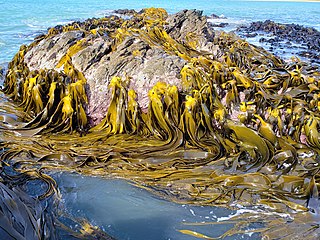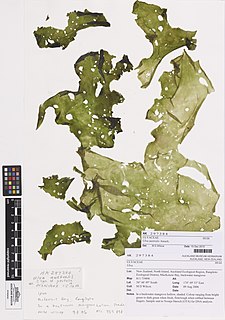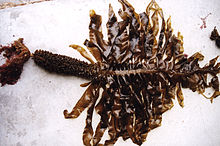
Nori(海苔) is a dried edible seaweed used in Japanese cuisine, made from species of the red algae genus Pyropia including P. yezoensis and P. tenera. It has a strong and distinctive flavor, and is often used to wrap rolls of sushi or onigiri.
Fucoxanthin is a xanthophyll, with formula C42H58O6. It is found as an accessory pigment in the chloroplasts of brown algae and most other heterokonts, giving them a brown or olive-green color. Fucoxanthin absorbs light primarily in the blue-green to yellow-green part of the visible spectrum, peaking at around 510-525 nm by various estimates and absorbing significantly in the range of 450 to 540 nm.

Wakame(Undaria pinnatifida) is a species of kelp native to cold, temperate coasts of the northwest Pacific Ocean. As an edible seaweed, it has a subtly sweet, but distinctive and strong flavour and texture. It is most often served in soups and salads.

The Chubut steamer duck or white-headed flightless steamer duck is a flightless duck endemic to Argentina.

Alariaceae are a family of brown algae in the order Laminariales.
Fucoidan is a long chain sulfated polysaccharide found in various species of brown algae. Commercially available fucoidan is commonly extracted from the seaweed species Fucus vesiculosus, Cladosiphon okamuranus, Laminaria japonica and Undaria pinnatifida. Variant forms of fucoidan have also been found in animal species, including the sea cucumber.

Durvillaea is a genus of brown algae in the monotypic family Durvillaeaceae. All members of the genus are found in the southern hemisphere, including Australia, New Zealand, South America, and various subantarctic islands.

1-Methylnicotinamide (trigonellamide) is a prototypic organic cation. 1-Methylnicotinamide is the methylated amide of nicotinic acid.

Seaweed, or macroalgae, refers to thousands of species of macroscopic, multicellular, marine algae. The term includes some types of Rhodophyta (red), Phaeophyta (brown) and Chlorophyta (green) macroalgae. Seaweed species such as kelps provide essential nursery habitat for fisheries and other marine species and thus protect food sources; other species, such as planktonic algae, play a vital role in capturing carbon, producing up to 50% of Earth's oxygen.
Wakame most often refers to Undaria pinnatifida, an edible seaweed.

Cleora is a genus of moths in the family Geometridae. The genus was erected by John Curtis in 1825.

Ballast water discharges by ships can have a negative impact on the marine environment. The discharge of ballast water and sediments by ships is governed globally under the Ballast Water Management Convention, since its entry into force in September 2017. It is also controlled through national regulations, which may be separate from the Convention, such as in the United States.

Seaweed farming or kelp farming is the practice of cultivating and harvesting seaweed. In its simplest form, it consists of the management of naturally found batches. In its most advanced form, it consists of fully controlling the life cycle of the algae.
Weissella koreensis is a species of Gram-positive bacteria in the family Leuconostocaceae. The bacteria has irregular cells, is tolerant of acid, and does not develop spores. It was described by Lee et al. in 2002.
Leuconostoc miyukkimchii is a Gram-positive, non-spore-forming, facultatively anaerobic and non-motile bacterium from the genus of Leuconostoc which has been isolated from the fermented algae Undaria pinnatifida from Korea.
Nazimah Hamid is a New Zealand food science academic, and as of 2017 is a full professor at the Auckland University of Technology.

Ulva australis, the southern sea lettuce, is a species of bright green coloured seaweed in the family Ulvaceae that can be found in waters around Australia and was first described by Swedish botanist Johan Erhard Areschoug. It is an edible green algae, although sometimes designated as a seaweed. General characteristics of Ulva australis include a smooth surface, distromatic blades, lobed fronds, and thallus color from dark green to light grass green. It can be either free floating or attached by a single holdfast. Its cells appear to be irregularly arranged, have rounded edges, and have shapes such as rectilinear, square, and pentagonal.
Formosa undariae is a Gram-negative, aerobic and rod-shaped bacterium from the genus of Formosa.
Winogradskyella undariae is a bacterium from the genus of Winogradskyella which has been isolated from the algae Undaria pinnatifida from Wando.
This page is based on this
Wikipedia article Text is available under the
CC BY-SA 4.0 license; additional terms may apply.
Images, videos and audio are available under their respective licenses.











